

|
◦ Challenger 4P ◦ OSI-400 Superboard Replica ◦ Links To OSI Resources |
|
Ohio Scientific Instruments (OSI for short) was known for making kit-based computers, focused primarily around the MOS 6502 processor.
They produced kits prior to the advent of the appliance computer, and continued to make machines thru the 1980s.
In general, their products require considerable tinkering to get them working these days, due to a mix of design shortcomings and dubious hobbyist construction techniques.
Many systems have modifications performed by their users which deviate from standard construction methods.
Usually these changes are intended to improve usability or add in new features, and while they are cool to see, they can be a headache to understand and debug.
Oh, and watch out for their power supplies. I'm not kidding, they're inefficient and underspecced for some higher-end builds.
And yet I find them charming. They have so much variation to them that really mirrors the person who built and maintained them back in the day. OSI really expected you to want to play around with their products, and to learn from them. The OSI-300, their first product, was a simple trainer with only 128 bytes of RAM and a crude front panel. The intent was for you to learn 6502 machine language and send it back to them for a $99 discount on a more advanced system. I'd love to find an original OSI-300 but for now I will contend with a mini OSI-300 replica. |
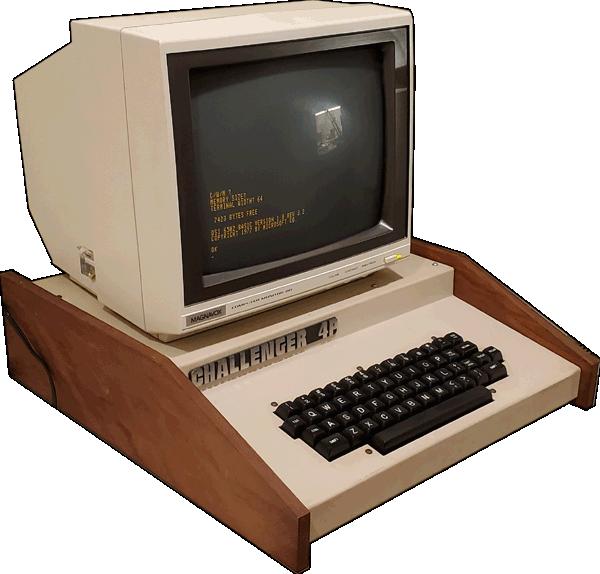
Model: Ohio Scientific Challenger 4P
Year: 1979
Processor: 6502 @ 2MHz
RAM: 8KB
ROM: 8KB BASIC + OSI Monitor
Video: 64 characters, 32 lines monochrome ASCII w/ extended character set (OSI-540B)
Or color ASCII (replica OSI-540B)
Sound: Tone generator
OS: OSI BASIC V2 Rev 3.2
|
|
My OSI Challenger 4P has had a few things replaced on it since I got it.
A few of the 2114 SRAM chips were dead and needed to be swapped out to give it back a full 8K.
The power supply was considerably hotter than it should have been, rendering the top of the machine untouchable in about 30 minutes of operation.
The internal wiring harnesses were also incredibly messy and sketchy, relying on electrical tape for insulation.
The keyboard also had a number of dead switches, which also needed replacement.
I took care of the keyboard and RAM problem first, rendering the machine atleast usable.
After a chance encounter at VCF West in 2019, I scored a box of OSI stuff, including an A15 backplane PCB. I removed the original wiring, along with the old backplane cover, and stand-alone dsub connectors, in favor of the A15 board and a chassis fan. Oh, and the power supply got replaced with a modern switchmode supply using an adapter plate to allow use of the original screw mounts. The result is much cleaner internally, runs at a reasonable temperature with a light breeze on your fingers as you type, and you don't risk your house catching on fire. I've finally got my replica 540B video board working! Now with color! The hope was to upgrade from my existing monochrome setup while experiencing the build process for myself. I made two different solder bridges which hampered operation for several years, as they were difficult to spot. With no solder mask to prevent these faults, it's a pretty easy mistake to make. I need to do a bit more adjustment to the analog circuitry where the elements of the video signal are combined. |
Click here to view the entire Challenger 4P gallery
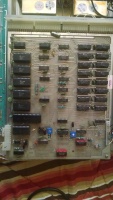

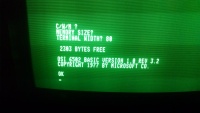
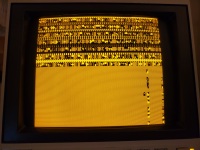

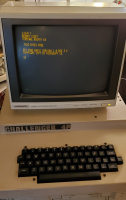

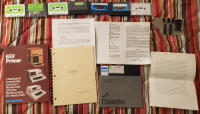



|
Model: Ohio Scientific 400 "Superboard" Replica Year: 1976 Processor: 6512 @ 1MHz RAM: 4KB (OSI-420C) ROM: 256B Monitor ROM Video: 32x32 monochrome uppercase ASCII (OSI-440) |
|
This machine is a kit build, not unlike many OSI machines, but this one can't really be considered a Challenger.
I'm starting with a glitchworks replica 400 board for CPU, which was tested with 1K of RAM, serial, and a simple ROM monitor (presumably OS65A).
I've adapted the CPU socket to use a 6512 in lieu of a 6502, and added a discrete level shifter for RS232.
I acquired an authentic 420C RAM board and 440 video board at VCF East XVIII, and added them all to a backplane. The 440 video board has a parallel ASCII keyboard input, which can be adapted for a number of keyboard models. One of the three suggested keyboards in the manual is the Sanders 720 terminal keyboard, a common surplus item in many 1970s hobbyist magazines like Byte. I own a 720 keyboard and decided this was the perfect use for it, despite its limitations and non-standard ASCII layout. However, I have elected to modify the keyboard slightly to my needs, while ensuring that every change is reversible (should a rare Sanders terminal turn up without a keyboard). I've fabricated a DC-37 to DB-25 adapter board to make interfacing with the native connector easier. I've also made an internal interposer board to add in features and places to connect additional key switches which include: ∘ Control (not present on the 720) ∘ Delete (present, but generates a non-standard ASCII code) ∘ Graphics mode toggle ∘ Reset I'll probably post the design files for both once I'm satisfied that they work properly. I've added an EEPROM socket and decode logic onto my 495 prototype board to provide eWOZMON support over serial -- it's easier to use than OS65A for debugging for the moment. Tests of writing to the 440 video board from serial, reading from the Sanders 720 from serial, and finally writing from the keyboard directly to the screen (albeit with a crude method). I've tried some tests with OS65V, but I've got an issue with the keyboard strobe containing runt pulses which appear as rapid keypresses. I've been attempting to debug that issue for the past 2 weeks now, focusing on the Sanders 720, with help from many members of the community, but we're still not sure how to solve it. I'm also testing a new self-contained power supply to replace using my bench equipment. I would like to run eWOZMON from video, OS65V, and possibly BASIC too, but really getting any sort of general functionality from the project will be nice. I also want to add parallel output from either a PIA or a RIOT, and some variety of sound output, even just something simple and appropriately 1970s. At present, the 440 video board is only equipped with RAM for storing text data, but I plan to add an additional 2KB of graphics RAM. The authentic method would be to use another 420C RAM board with ribbon cables. I will instead be using a newer 2KB SRAM chip (a Synnertek 2128 probably) for convenience sake. I've been laying out a hand wired prototype mezzanine board to plug directly into the headers on the 440, we'll see how that goes. The main issue is that the original 420C would have 2102 SRAMs with independent data in and out pins, preventing on-screen interference while writing to the graphics RAM. The new method will require an extra buffer to achieve the same functionality. Ultimately, this will be similar in function to an original Challenger 65V-4K from OSI. |
Click here to view the entire OSI-400 gallery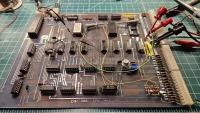
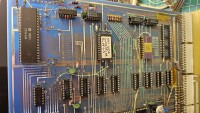
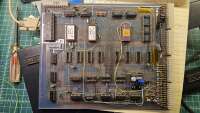
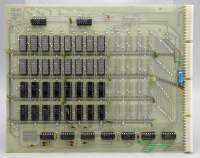
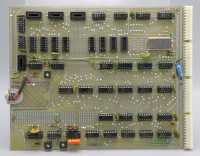
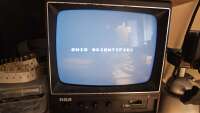
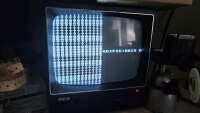
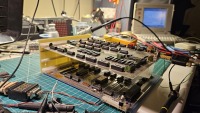
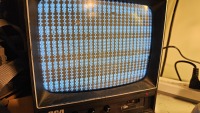
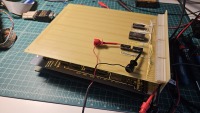
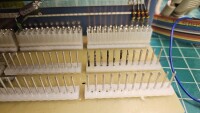
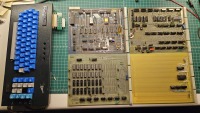

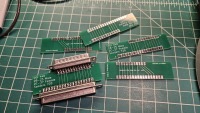
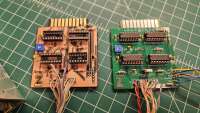
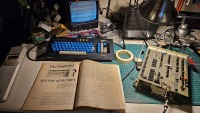
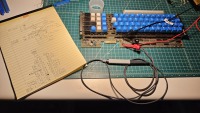
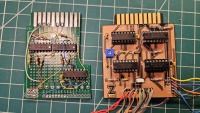
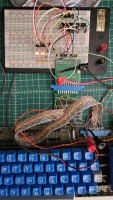
|
|
Dave's OSI Repository - Hardware information, documentation, and community forums for OSI enthusiasts. Start here if you're new to OSI Mark's Ohio Scientific/Compukit UK101 Archive - Hardware information, software, documentation, emulator, and other useful tools and information Glitchworks OSI projects - Glitchworks builds great OSI replica boards and kits, improving accessability for those who want to get into OSI stuff David Gesswein's OSI Floppy Test Software - A useful utility if you have a floppy-based OSI system OSI-300 Replica Test Programs - Software written for the very limited OSI-300 OSI-300 Mini Trainer Replica - Tiny OSI-300 Mini! How I got into OSI stuff OSI Model 300 case mod - A perspective from an OSI-300 user who upgraded his with a better front panel Early Computer: OSI Model 300 Computer Trainer - OSI-300 information WinOSI emulator - Thomas Buescher's WinOSI emulator project |
created with igal2 2.2